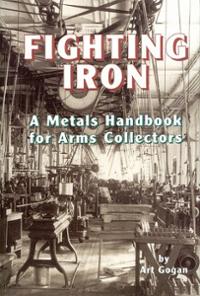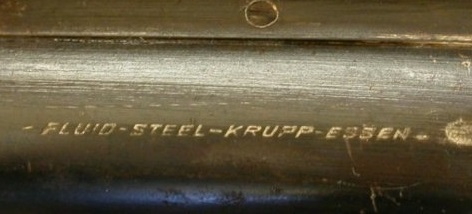 What is the difference between a Damascus knife and a Damascus shotgun? Why did barrel composition contribute to the short lifespan of the 6mm Lee Navy concept? Why did high-grade flintlocks use platinum touchhole sleeves? Why are early Rock Island Arsenal M1903 receivers considered potentially dangerous? Sooner or later, any gun collector is going to wind up with a question like these, and find himself in need of a basic education metallurgy. Well, Art Gogan has you covered, with Fighting Iron: A Metals Handbook for Arms Collectors
What is the difference between a Damascus knife and a Damascus shotgun? Why did barrel composition contribute to the short lifespan of the 6mm Lee Navy concept? Why did high-grade flintlocks use platinum touchhole sleeves? Why are early Rock Island Arsenal M1903 receivers considered potentially dangerous? Sooner or later, any gun collector is going to wind up with a question like these, and find himself in need of a basic education metallurgy. Well, Art Gogan has you covered, with Fighting Iron: A Metals Handbook for Arms Collectors.
There are not many other sources of this type of information short of all-out college textbooks, and Gogan has done a great job compiling a quite readable history and description of the metals that apply to the world of arms, primarily firearms. As one might expect, this is primarily iron and steel – but there is information on virtually every other element and alloy that came in contact with weaponry – copper, brass, bronze, gold, silver, lead, tin, and more. The book is aimed at more historical collectors, and does not include the more recent developments, such as use of aluminum, titanium, or scandium alloys. Not many weapons made from those materials are considered collectible yet, though.
For me, the most useful section of the book was the history of how iron has been alloyed into steel over time, dating back to the beginning of the Iron Age. It was only relatively recently that metalsmiths have been able to accurately measure the component elements of a particular steel, and before that the terminology used could be baffling. Fluid steel, cast steel, silver steel, decarbonized steel – the list goes on, and that’s without including steels that were simply named for their geographic origin. What is the difference between Toledo steel, German steel, Swedish steel, and British steel? Even a serious textbook probably won’t tell you that, but Fighting Iron does.
As a practical example, consider this stamping:

The “Krupp Essen” part is understood easily enough; Krupp was one of the largest steel producers in the world and located in the city of Essen. But what does Fluid Steel mean? Well, it is the name given to a specific production method, and it can help us date the gun in question. In the 1850s an Englishman named Henry Bessemer was granted a patent for a fast and automated method of removing carbon and slag from pig iron, creating a very clean raw steel that could be then alloyed to whatever specification a producer desired. The process involved blowing high-pressure air through molten pig iron, and while it worked well, it often resulted in air bubbles left in the solidified end product. To solve this problem, another Englishman named Sir Joseph Whitworth (yes, the man behind the Whitworth rifle) developed a hydraulic press to compress the Bessemer process steel as it cooled, thus collapsing any internal voids it might contain. Whitworth’s method became known as fluid steel because of the hydraulic means of applying pressure, and it was adopted by Krupp, among others. As always eventually happens, fluid steel was eventually superceded by better processes, and was not used after about 1920. That gives us a time frame for a gun like the one pictured above – it could have been made no earlier than the late 1850s and no later then the 1920s.
This, and much more occasionally-instrumental knowledge can be yours with a thorough reading of Art Gogan’s “Fighting Iron”! It was published in 1999 and is still easily accessible through the publisher (Mowbray) or Amazon for the $28 cover price:

Now this is truly a book for the hardcore enthusiast. Metals are fascinating, and indeed, we all occasionally wonder about materials in addition to design. Will definitely be picking this one up 🙂
This is awesome – and way cheaper than “The Knight And The Blast Furnace”, which does something similar for medieval and early renaissance armour. Buying this now. Thanks, Ian!
Yes, I had the exact same thought. I always have a hard time justifying spending $300+ on a book!
“Fighting Iron” is a really good book for the firearms collector, but it does not really tell you much about modern metallurgy as it applies to the firearms of today.
The best general modern metals reference for firearms enthusists and engineers is “Metallurgy for the Non-Metallurgist” by Harry Chandler, edited by Arthur C. Reardon, and still published by ASM International:
http://www.asminternational.org/portal/site/www/AsmStore/ProductDetails/?vgnextoid=eb0b76d47ff2f210VgnVCM100000621e010aRCRD
Another book specifically on weapons metallurgy is “Military Metallurgy” by Alistair Doig. Doig was an ROF metallurgist and he covers modern vehicle armor, projectiles, grenades, cannon barrels, bridging equipment, and other nifty subjects. Its coverage of tank gun barrels and grenades is particularly interesting. The book is out of print, but copies show up on Amazon, Abe’s Books, and eBay from time to time:
http://www.amazon.com/gp/product/1861250614/ref=as_li_ss_tl?ie=UTF8&camp=1789&creative=390957&creativeASIN=1861250614&linkCode=as2&tag=forgoweapo-20
By the way, Bessemer really did not invent the ‘Bessemer’ process – he lifted the idea from an American. William Kelly invented pneumatic steelmaking and launched it at the Eureka Steel Works in Wyandotte, Michigan at the outset of the U.S. Civil War (1861). Kelly’s mill provided railway steel, firearms steel, and armor for the Union forces thoughout the Civil War. Its low cost and massive volume of production gave the Union a major advantage over the Confederacy. Bessemer did not get a mill up and running in England until 1864.
Kelly has been denied credit for his achievment due to the peculiarities of the British patent system. Sam Colt patented all his inventions in England first to comply with the British patent system – Kelly did not. Getting a U.S. patent first barred one from getting a British patent, allowing others to steal your ideas. An interesting subject for another post.
Yep, the book does discuss Kelly and who really invented the process – that was just a bit more detail than I wanted to delve into in a review.
It’s actually a little more complicated than that. The Bessemer process on its own in its original form tended to be unreliable as to the quality of steel produced. Other steel makers in Britain refined the process through a lot of effort and discovered ways of making it reliably produce steel with known qualities. They then partnered with Bessemer to license these refinements to others. That’s what made Bessemer so successful as a businessman.
The idea of the ‘lone inventor’ coming out with an earthshaking new innovation all on his own makes for good PR and dramatic literature, but it rarely happens in practice. What seems to happen more often is that the original ‘invention’ doesn’t really work that well, but other people build on it to make something that does.
The firearms industry is a really good example of that. How many rifles or pistols that were the ‘first’ in some field were really that good of a weapon? Now look at how many really great firearms were just refinements of ideas that had been around for a while.
Pick just about any other field of technology and you’ll usually find more or less the same thing once you get to know more about what really happened.
William Kelly developed pneumatic steelmaking without any outside help which made his development all the more remarkable. Bessemer did not get his process off the ground until he sent agents from Canada to observe the process in Wyandotte.
I’d love to get my hands on this book. I did a paper for school on the effects of the change from bronze cannons to iron cannons in the civil war and found the subject enthralling…but I’m weird that way. It was only a short 15 pages, but I would have liked a book like this to reference.
A great book with a lot of fascinating information.
Well worth the money.
The sciences of metallurgy, metal-working and materials technology are the foundation stones of nearly every aspect of hard engineering, industrial construction and manufacturing. Firearms are no exception.